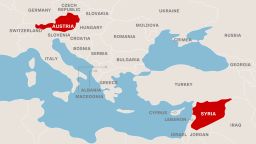Story highlights
Thousands of migrants are stranded in Serbia as European borders tighten
U.N. refugee agency says the worst bottlenecks are on the Croatia-Serbia border
Slovenia accuses Croatia of "disproportionate demands" on the numbers it should take
Thousands of migrants and refugees are stranded in Serbia as countries farther west in Europe tighten restrictions on their borders.
About 10,000 refugees are in Serbia, where they are facing shortages of aid and shelter, the U.N. refugee agency, the UNHCR, told CNN.
Spokesman William Spindler said limits on the flow of migrants had also produced bottlenecks on Serbia’s border with its western neighbor Croatia and with Croatia’s neighbor Slovenia.
Babar Baloch, a UNHCR spokesman in Bratislava, Slovakia, described the situation as desperate, saying that reception capabilities in Serbia and Croatia were not adequate for the number of people being held.
The worst hot spot between the two countries was Bapska on the Croatian side of the border and Sid on the Serbian side, the spokesman said.
Croatia’s Interior Ministry said in a statement on its website that 1,079 migrants had entered the country Monday, with more expected.
The country’s temporary admissions centers were currently holding 3,036 “vulnerable persons,” the ministry said, and from Croatia the transfer of migrants to Slovenia was “ongoing.”
In total, 198,259 migrants have entered Croatia since the beginning of migrant crisis, the ministry said.
Slovenia: Croatia’s demands ‘disproportionate’
Slovenia’s Interior Ministry earlier said Croatia had made “disproportionate demands” that it receive at least 5,000 migrants a day – twice its self-imposed limit of 2,500.
Slovenia, which borders Croatia, Hungary, Austria and Italy, has a population of a little more than 2 million people.
Slovenian Interior Minister Gyorkos Znidar had asked for Croatia to respect restrictions on the number of migrants the country could receive each day, the ministry said Sunday.
“We subsequently received an official announcement from the Croatian authorities that they were planning to send up to 1,800 migrants to Slovenia by the morning.
“The police have rejected this announcement,” a ministry statement said. “We believe that we can only be successful in resolving the present crisis if we tackle it together and cooperate closely. Such unilateral approach on the part of the Republic of Croatia will not contribute to resolving the situation.”
Austrian border
Slovenia had already received a train carrying some 1,800 people Sunday and was expecting another 300 to 350 in the afternoon, it said.

The ministry also said Austria had stated that it was unable to take more migrants “as they were facing great difficulties in providing adequate accommodation and care.”
But a spokesman for the Austrian Interior Ministry told CNN on Monday that the Austrian-Slovenian border was open.
“There are border checks, but that is it,” spokesman Karl Heinz Grundboeck said.
According to Austrian police, around 3,000 migrants entered the country from Slovenia over the weekend, Grundboeck said. He said migrants were no longer crossing into the country from Hungary.
Hungary closes ‘green borders’
Accused of a heavy-handed response to the thousands of migrants and refugees crossing over its borders in recent months, Hungary closed its border with Croatia at midnight Friday, saying the only legal entry into the country would now be restricted to official border crossings.
“The legal option, the legal possibility to come to Hungary and therefore to the European Union through the Schengen borders is open, but the green borders, the natural borders of the country, are sealed,” spokesman Zoltan Kovacs said in announcing the closure.
Last month, Hungarian riot police used tear gas and water cannons to turn people back at the border with Serbia. Hungary rushed to erect a razor-wire barrier to keep migrants out and threatened anyone crossing the fence with jail time.
Hungary’s move comes as Europe struggles to fashion a coherent response to a historic wave of people fleeing conflict and destruction in the Middle East and North Africa – primarily from Syria, where a civil war has raged for more than four years, claimed the lives of more than 200,000 people and left cities in ruins.
Seeking refuge: Full coverage of the migration crisis
Aiming for European shores
Europe is facing its largest refugee and migrant crisis since World War II.
People fleeing the violence in Syria account for the largest portion of those arriving on European shores, but there are many others on the move from African nations and elsewhere.
At least 613,000 migrants have crossed by boat into Europe seeking safety and sustenance so far this year, according to the International Organization for Migration. More than 3,100 have drowned or disappeared during the perilous journey.
At least 472,000 of the desperate travelers have landed in Greece, and more than 137,000 in Italy, the migration group said. From there, they try to reach the more sought-after EU nations for migrants such as Germany and Sweden.
Germany is expecting 1 million asylum applications this year and has a backlog of more than 260,000 cases.
France has agreed to take tens of thousands and Britain 20,000. Switzerland said that if Europe can come to agreement, it will take 1,500 refugees. Most of Eastern Europe has resisted committing to a number.
